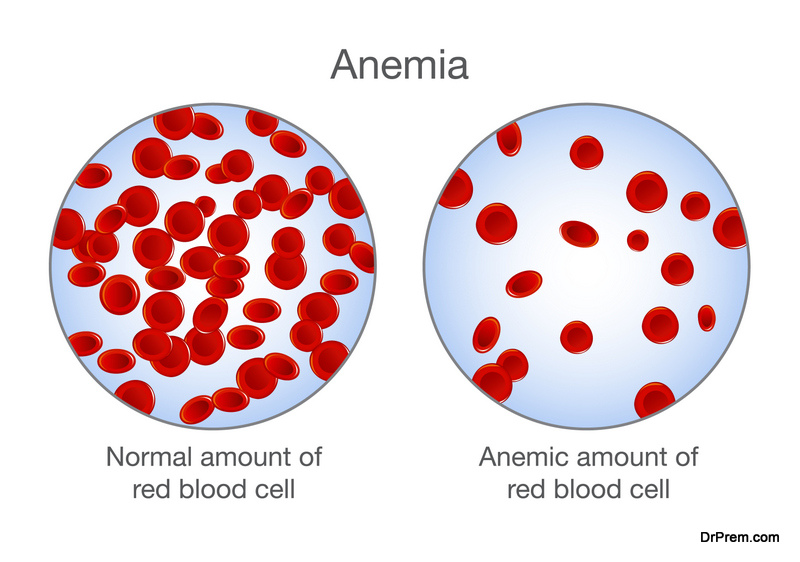Iron deficiency or low hemoglobin is also known as anemia. Symptoms of anemia include tiredness, sleepiness, fatigue, feeling lethargic, skin appearing pale, etc. The cure of anemia is simple as it is the intake of iron supplements. However, you need to know if you really are anemic or there are other reasons associated with these symptoms. These symptoms can also be related to depression, diabetes, or other problems. Self-medication is no harm, still, before you take any medicines you need to be sure about the reason behind taking them.
You are also at a greater risk of suffering from anemia if you are diabetic. For symptoms of anemia in diabetic patients and suggestions for treatment, check out the latter section of the article.
Check your eyelids
 Eyelids of any human being of any race are easy to check as it gives you an almost accurate result. Start with looking at yourself into the mirror. For this test, you need to check your lower eyelid. Pull it down to watch it. Your eyelid appears to look pale whilst moving towards the light. The color of your eyelid needs to turn pink quickly, however, if it takes a little longer or if it doesn’t change at all you are anemic. This means you need medication.
Eyelids of any human being of any race are easy to check as it gives you an almost accurate result. Start with looking at yourself into the mirror. For this test, you need to check your lower eyelid. Pull it down to watch it. Your eyelid appears to look pale whilst moving towards the light. The color of your eyelid needs to turn pink quickly, however, if it takes a little longer or if it doesn’t change at all you are anemic. This means you need medication.
Check your nails
If your nail bed turns pale bluish you are said to be anemic. You need to look at the half moon area near the cuticles of your nail bed. However, if you have a darker skin tone this test tip might not give you the exact result unless you know the color of your nail bed well. All you need to do is maintain a track of the color of your nail bed. If it is towards bluish you are anemic.
Checking anemia with a gold ring
 This test is very simple. Take a gold ring and wash it properly first to get rid of any deposit. Now rub the ring on your right cheek from top to bottom for 30 seconds. If you see a fine blue line on your cheek, you are anemic. You can compare the difference by comparing both your left and your right cheek in the mirror.
This test is very simple. Take a gold ring and wash it properly first to get rid of any deposit. Now rub the ring on your right cheek from top to bottom for 30 seconds. If you see a fine blue line on your cheek, you are anemic. You can compare the difference by comparing both your left and your right cheek in the mirror.
A similar test can be performed on your palm. Keep your right hand on a plain surface with your palm facing upwards. Try to balance the gold ring on your palm for 10 minutes. If you are anemic a black circle appears on your palm. Moreover, when you research online, you are sure to find sites, such as Natural Adviser, that provide valuable information about anemia tests and other diseases, in easy to understand manner.
Dr Prem Jagyasi says, “These small symptoms can help you detect anemia at home. You need not go to the doctor and spend huge bucks to confirm anemia. Though once detected you are anemic, you can go and treat it yourself.” Over the counter iron supplements are available to cure mild anemia. You can also consume iron-rich food to help you deal with the situation. Anemia can be cured and the cure should not be not delayed. Chronic anemia can cause a lot of other chronic problems.
Check your lips
The color of your lips also indicates anemia. As anemia tends you make you look pale and so does the color of your lips change to pale. Be it a human being with any skin tone lips appears pale when anemic.
Main Causes of Anemia
To make sure whether you have anemia or not, it is necessary that you learn about its underlying causes going before going for self-test for anemia and coming to any conclusion. For your reference, given below are eleven most likely causes of anemia.
1. Bone marrow
 Diseases linked to the bone marrow can also play a substantial part in cutting down the red blood cell count. Blood cancers, like lymphomas and leukemia, alter red blood cell production and hence give way to anemia. The fewer the production of red blood cells in the bone marrow, the more anemic the person becomes. The effects of these cancers can bring about life threatening or even mild alteration of the red blood cell production process. Other cancers linked to the bone marrow or blood, such as myeloma and lymphoma, also give way to anemia like conditions.
Diseases linked to the bone marrow can also play a substantial part in cutting down the red blood cell count. Blood cancers, like lymphomas and leukemia, alter red blood cell production and hence give way to anemia. The fewer the production of red blood cells in the bone marrow, the more anemic the person becomes. The effects of these cancers can bring about life threatening or even mild alteration of the red blood cell production process. Other cancers linked to the bone marrow or blood, such as myeloma and lymphoma, also give way to anemia like conditions.
2. Thalassemia

Another cause of anemia linked to hemoglobin is thalassemia. This condition can also vary based on the severity. Thalassemia is a quantitative abnormality. This means that an insufficient quantity of hemoglobin molecules are produced.
3. Hemolytic anemia
 In this condition, the red blood cell ruptures and hence does not have the right shape for proper functioning. The hemolysis of the cell leaves it dysfunctional. A variety of reasons can be held responsible for this condition, including hereditary causes. Even normal red blood cells can be affected due to this condition.
In this condition, the red blood cell ruptures and hence does not have the right shape for proper functioning. The hemolysis of the cell leaves it dysfunctional. A variety of reasons can be held responsible for this condition, including hereditary causes. Even normal red blood cells can be affected due to this condition.
4. Sickle cell
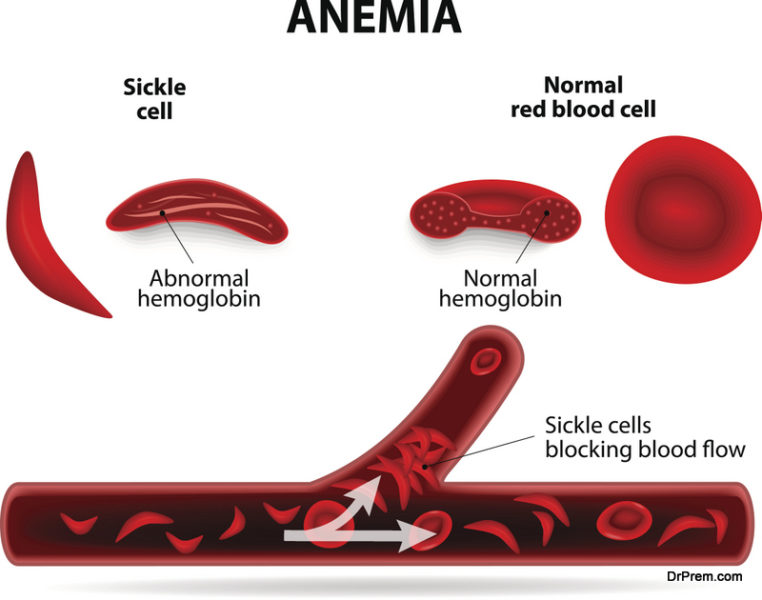 In certain cases, individuals face abnormal production of hemoglobin molecules. This is a functional problem of red blood cells. The cells become crescent shaped and, hence, cannot function like a normal red blood cell. This condition is mostly hereditary and it impacts the important process of oxygenation. A normal red blood cell carries oxygen but a sickle cell cannot undertake this process because of its structural difference.
In certain cases, individuals face abnormal production of hemoglobin molecules. This is a functional problem of red blood cells. The cells become crescent shaped and, hence, cannot function like a normal red blood cell. This condition is mostly hereditary and it impacts the important process of oxygenation. A normal red blood cell carries oxygen but a sickle cell cannot undertake this process because of its structural difference.
5. Pernicious anemia

Sometimes the stomach and intestine do not properly absorb vitamin B12. This causes pernicious anemia. This type of anemia is linked to the gastrointestinal tract. The autoimmune process of the human body is cited as the reason behind this condition.
6. Improper nutrition
 The production of red blood cells greatly depends on the intake of minerals and vitamins. Apart from iron, other essential contributors include folate and vitamin B12. A deficiency of the latter two can give way to anemia because of inadequate red blood cell production. Low folate and vitamin B12 levels indicate improper dietary consumption. Sufficient vitamin intake is necessary for red blood cells production.
The production of red blood cells greatly depends on the intake of minerals and vitamins. Apart from iron, other essential contributors include folate and vitamin B12. A deficiency of the latter two can give way to anemia because of inadequate red blood cell production. Low folate and vitamin B12 levels indicate improper dietary consumption. Sufficient vitamin intake is necessary for red blood cells production.
7. Pregnancy
 During pregnancy, a woman undergoes water weight gain which dilutes blood and can cause anemia. Anemia during pregnancy is very common. The blood quantity in the body radically increases during pregnancy, but the hemoglobin level drops down. Nutrition is the best way to prevent such an anemia. Iron intake during pregnancy is vital for the wellness of the baby and the mother.
During pregnancy, a woman undergoes water weight gain which dilutes blood and can cause anemia. Anemia during pregnancy is very common. The blood quantity in the body radically increases during pregnancy, but the hemoglobin level drops down. Nutrition is the best way to prevent such an anemia. Iron intake during pregnancy is vital for the wellness of the baby and the mother.
8. Kidney disease
 A hormone called erythropoietin is released by the kidneys which lets the bone marrow create red blood cells. If a person is suffering from a chronic kidney condition then the production of erythropoietin is greatly diminished. This, consequently, reduces red blood cell production, giving way to anemia.
A hormone called erythropoietin is released by the kidneys which lets the bone marrow create red blood cells. If a person is suffering from a chronic kidney condition then the production of erythropoietin is greatly diminished. This, consequently, reduces red blood cell production, giving way to anemia.
9. Chronic diseases
 Chronic conditions like HIV/AIDS, cancer, Crohn’s disease, rheumatoid arthritis etc, can greatly interfere with red blood cell production. This results in chronic anemia. Renal failure can also be associated with the condition.
Chronic conditions like HIV/AIDS, cancer, Crohn’s disease, rheumatoid arthritis etc, can greatly interfere with red blood cell production. This results in chronic anemia. Renal failure can also be associated with the condition.
10. Deficiency of iron
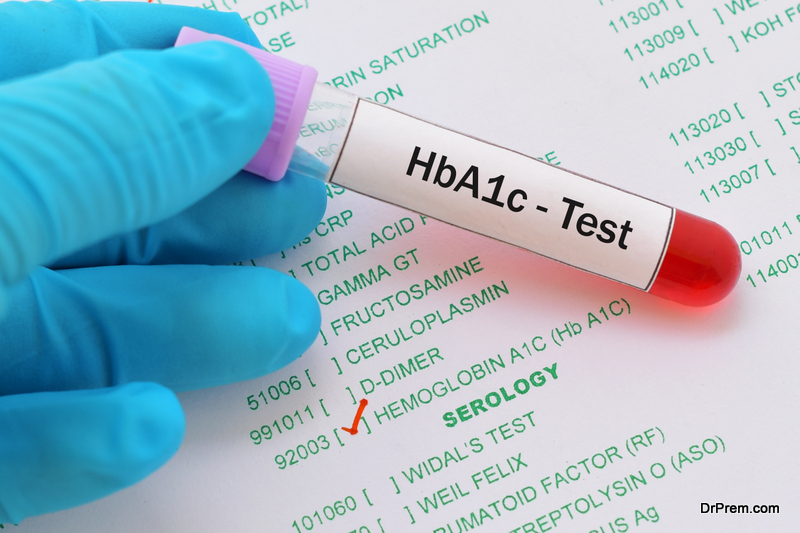 Iron is required by the bone marrow for the production of red blood cells. In the molecular structure of hemoglobin, iron plays a very significant role. Inadequate dietary intake of iron can result in anemia. Chronic bleeding can also limit the quantity of iron in our body.
Iron is required by the bone marrow for the production of red blood cells. In the molecular structure of hemoglobin, iron plays a very significant role. Inadequate dietary intake of iron can result in anemia. Chronic bleeding can also limit the quantity of iron in our body.
11. Active bleeding
 Constant blood loss due to various reasons, including wounds and menstrual flow, can cause anemia. At times, cancer can also result in slow blood loss which gives way to anemia.
Constant blood loss due to various reasons, including wounds and menstrual flow, can cause anemia. At times, cancer can also result in slow blood loss which gives way to anemia.
How are diabetes and anemia connected?
Diabetes, in the medical world, is considered to be the most dreaded disease. It affects the entire body. A person suffering from high blood glucose cannot undergo any surgery as it would prove futile and risky. Diabetes also brings along other uninvited complications like eye problem, heart disorders, dental problem, and skin allergies. This ailment also causes anemia as it sucks away the blood from the body.
Correlation between diabetes and anemia
High diabetes causes anemia:
 1. The presence of a higher blood glucose level and its gradual rise causes kidney malfunction. This particular condition is called diabetic neuropathy. Due to this, the kidney starts showing abnormality in the synthesis of erythropoietin, a hormone which controls the production of red blood cells. Consequently, this condition also affects the basic function of the red blood cells, that is, to transfer oxygen to different organs of the body. This eventually leads to the anemic condition.
1. The presence of a higher blood glucose level and its gradual rise causes kidney malfunction. This particular condition is called diabetic neuropathy. Due to this, the kidney starts showing abnormality in the synthesis of erythropoietin, a hormone which controls the production of red blood cells. Consequently, this condition also affects the basic function of the red blood cells, that is, to transfer oxygen to different organs of the body. This eventually leads to the anemic condition.
2. Diabetes also affects nerves, in some patients, which results in less production of erythropoietin hormone which ultimately leads to an anemic condition.
3. Anemia can be caused in diabetic patients due to some diet restrictions, due to which they fall short of certain nutrients. Diabetes type 1 patients have a higher risk of contracting autoimmune diseases such as celiac disease and pernicious anemia which mainly occurs due to deficiency of vitamin B12. Both of the disorders share the common trait and that is less blood count condition and hence the reason for the anemic condition.
4. Types of medicines taken by a diabetic patient can also be one of the reasons for the occurrence of anemia. Doctors have reported that treatment of diabetes and hypertension are highly responsible for the risk of anemia.
Symptoms for an anemic condition in diabetic patients
It is difficult to detect whether a diabetic person is anemic or not as both these ailments share common symptoms. However, some anemic symptoms are as follows:
a) Pain in chest
b) Headache
c) Paleness of skin
d) Coldness and numbness in the hands and feet
e) Irritation in behavior
f) Shortness of breath while doing any physical activity
g) Faster heartbeat
The severity of untreated anemia condition in diabetes
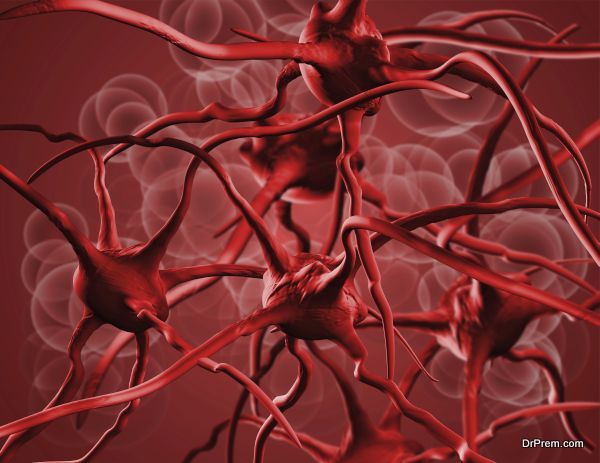
It is been reported through various case studies that untreated anemia in diabetic patients leads to a higher risk of contracting eye disease, cardiac disorders, and stroke condition. This can also result in death.
Treatment and prevention tips for anemia in diabetic patients
If anemia can be diagnosed at the early stages in diabetic patients, it can be cured from its roots. The treatment of anemia also depends on its cause. Accordingly, varied supplements such as iron or multivitamin medicines are prescribed by the doctor. The beneficial fact on this treatment includes suppressing the side complications of diabetes such as damage to nerves, eyes or kidneys. To some extent anemia treatment also helps in preventing malfunction of kidneys as the patient takes a drug called erythropoiesis which helps in increasing the count of red blood cells that are important for the functioning of the kidneys.
Diabetic patients must follow some prevention steps to check anemia and keep it from occurring:
1. Maintain blood sugar level
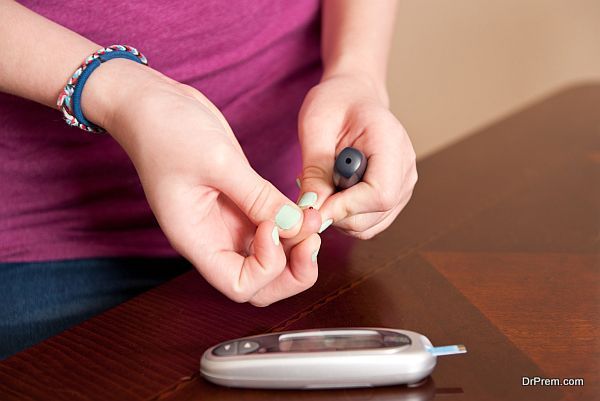 Keep monitoring your blood sugar level at least twice in a day so as to know your diabetic condition. You can check it yourself with the help of glucometer, an instrument used to monitor blood sugar level in your blood.
Keep monitoring your blood sugar level at least twice in a day so as to know your diabetic condition. You can check it yourself with the help of glucometer, an instrument used to monitor blood sugar level in your blood.
2. Maintain normal blood pressure
Normal blood pressure helps to keep the body function better. A diabetic patient must ensure to check his BP regularly. High BP in diabetic patients can lead to severe complications. The optimum value of blood pressure should not exceed above 130/80 mm Hg. Blood pressure can also be controlled by a balanced diet of taking less salt, alcohol and refraining from oily foods. You also need to check your body weight and if in excess must control it by doing exercises.
3. Have a nutritious diet mainly rich in iron
 Anemia is mainly caused due to deficiency of iron element in our blood. Hence you must take iron rich food such as spinach (richest source of iron), cooked dry beans, iron fortified whole grains, apricots. Non-vegetarians can also take tuna fish.
Anemia is mainly caused due to deficiency of iron element in our blood. Hence you must take iron rich food such as spinach (richest source of iron), cooked dry beans, iron fortified whole grains, apricots. Non-vegetarians can also take tuna fish.
4. Have vitamin-C rich food
Vitamin-C contains a high level of iron. The main sources of Vitamin-C are all citrus fruits such as lemon, orange, tomatoes, and cabbage, sprouts and parsley.
5. Avoid intake of caffeine:
 Studies have been reported that caffeine actually blocks the absorption process of iron in the body. Most of the beverages consist of one compound named polyphenols which actually inhibits the iron absorption from sources like green leafy vegetables and beans. And eventually creates difficulty in maintaining blood sugar level in diabetic condition.
Studies have been reported that caffeine actually blocks the absorption process of iron in the body. Most of the beverages consist of one compound named polyphenols which actually inhibits the iron absorption from sources like green leafy vegetables and beans. And eventually creates difficulty in maintaining blood sugar level in diabetic condition.
Go for your regular checkup with your doctor and alarm him or her if you find any discomfort or strain. A proper and regular checkup would prevent anemia.


